Keyword Density: What It Is & How to Calculate It [3 Methods]
Gabriela Jhean
What Is Keyword Density?
Keyword density is a metric used in SEO to measure the frequency of a specific word or phrase within a piece of text. It’s calculated as a percentage, representing the number of times a keyword appears compared to the total word count.
For example, if a keyword appears 10 times in a 500-word article, the keyword density would be 2%.
Table of Contents
Does Keyword Density Still Matter for SEO?
In the early years of SEO, keyword density was high due to a practice called keyword stuffing.
Keyword stuffing is the excessive repeated use of keywords within content to rank higher. Back then, search engines weren’t sophisticated enough to recognize this tactic for what it truly was: a manipulation of the system.
However, search engines have evolved significantly since then. They now prioritize high-quality, relevant content that provides value to users.
Keyword stuffing is no longer effective and can actually harm your SEO efforts. Over-optimization can lead to penalties from search engines, as it’s seen as a spammy tactic.
As a result, modern SEO best practices focus less on keyword density and more on creating content that is informative and engaging.
Keyword density can help you gauge the topic focus of your content, but it shouldn’t be the primary focus of your optimization efforts.
How to Calculate Keyword Density: 3 Methods
Method 1: Manually — The Keyword Density Formula
Calculating keyword density manually involves a straightforward formula:
Keyword Density = (Number of Keyword Occurrences / Total Word Count) * 100
Here’s how to use the keyword density formula:
- Count the total number of words in your text.
- Count the number of times your target keyword appears.
- Divide the number of keyword occurrences by the total word count.
- Multiply the result by 100 to get the percentage.
And here’s an example:
Imagine an 800-word article that contains the keyword “keyword density” 20 times. The keyword density of this article would be (20/800) * 100 = 2.5%.
Method 2: With Tools — Keyword Density Checkers
While manual calculation is easy enough for short pieces of content, it becomes increasingly time-consuming and impractical for longer articles. Thankfully, numerous online tools and software can efficiently calculate keyword density.
Keyword density checkers typically function by:
- Allowing you to input your text.
- Analyzing the content for specific keywords.
- Calculating and displaying keyword density percentages.
Here are a few popular and free keyword density checkers:
1. WPBeginner Keyword Density Checker
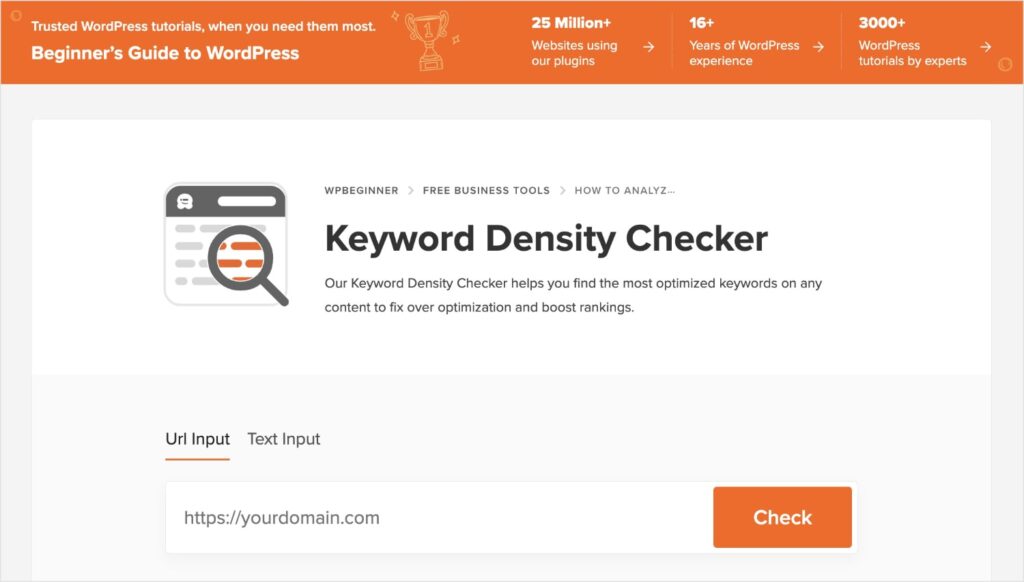
With WPBeginner’s Keyword Density Checker, you can enter a URL or text. The tool will give you several lists organized by word count (one word, two words, and three words). This makes it easy to locate your target keyword and get an idea about your overall keyword usage.
I also like that just below your results there’s a full article about how to analyze keyword density and fix over-optimization. This is great for beginners who are still navigating keyword density and learning how to leverage it for SEO.
2. SEO Review Tools Keyword Density Checker
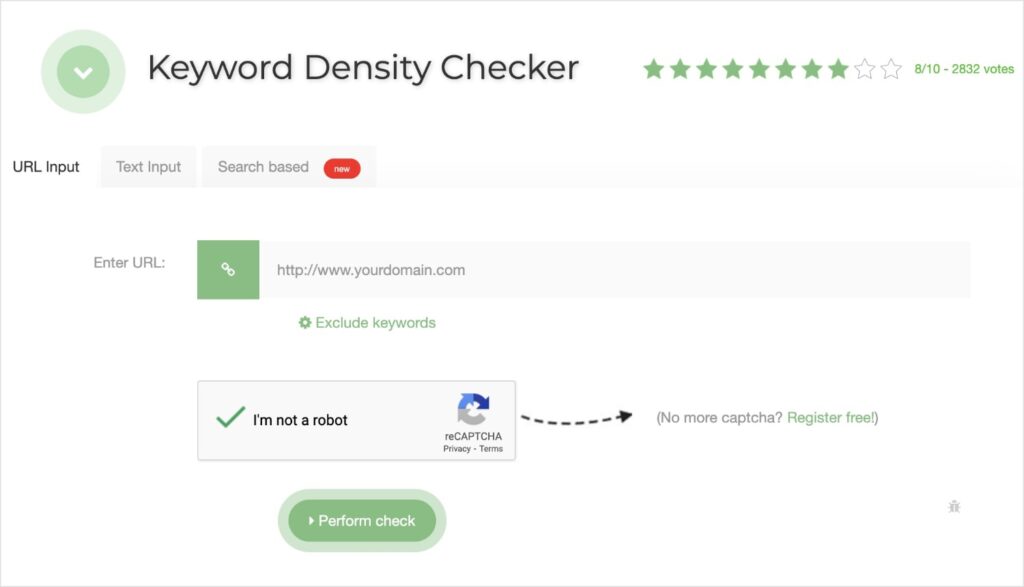
Similar to WPBeginner, SEO Review Tools generates keyword lists by word count. It also includes some visual aids to bring your attention to specific elements. For example, a green check mark that says, “Great! No signs of keyword stuffing / over-optimization.”
There’s also a yellow warning sign that says, “Warning: X Keyword(s) found with a high keyword density percentage.” The tool will generate the number of keywords with this issue, making it easy to catch over-optimizations.
3. Small SEO Tools Keyword Density Checker
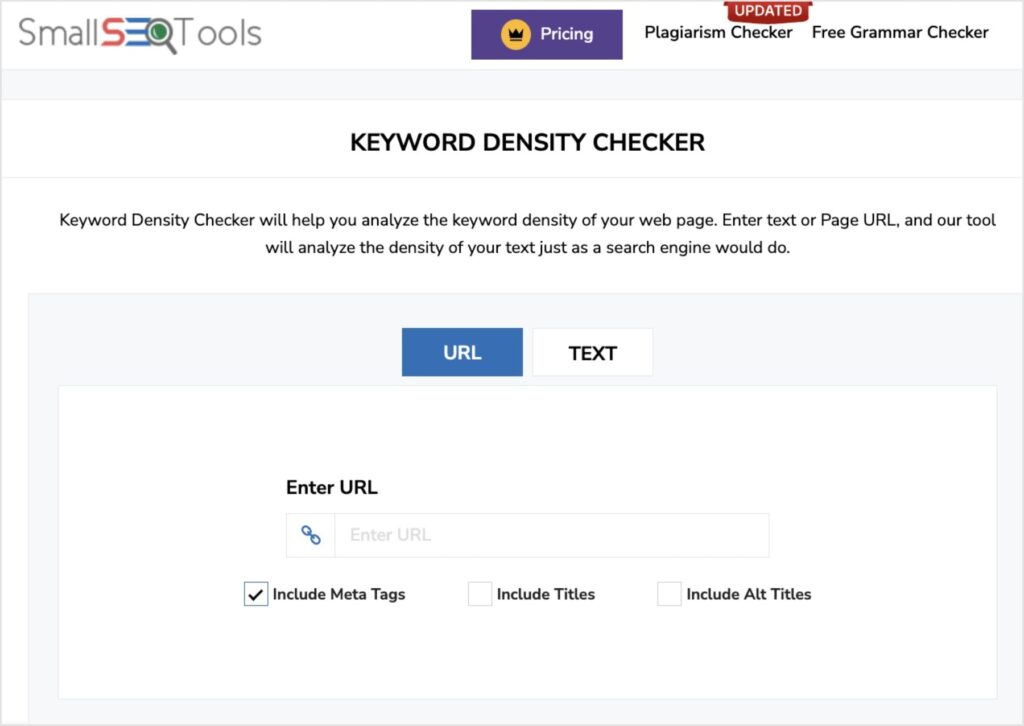
Small SEO Tools’ Keyword Density Checker has the same input capabilities as WPBeginner, but you get additional insights about your content optimizations. One of the most notable is how it generates a list of your Top Keywords.
Small SEO Tools also shows when you’ve included a specific keyword in the title, description, or header tag. It designates its use with a green checkmark or a red X, as shown below.

If you’re a visual person, these elements make Small SEO Tools stand out against the other keyword density tools mentioned.
Method 3: In WordPress — SEO Plugins
For WordPress users, integrating keyword density checks into your workflow is simplified through SEO plugins. These plugins offer a range of features to optimize your website, including keyword analysis.
All in One SEO (AIOSEO) is a popular choice among WordPress users. It offers a comprehensive suite of tools for improving your website’s visibility.

TruSEO is one of its standout tools, which helps you optimize your content for your primary keyword and assess its density.
First, you set a focus keyword in the WordPress editor. Then, the tool will analyze your optimizations for it.
TruSEO runs a thorough series of on-page SEO checks to provide insights into how you can improve your content. You’ll get this data in action-oriented checklists.
Here’s an example of the Focus Keyphrase Checklist with items you “passed”:
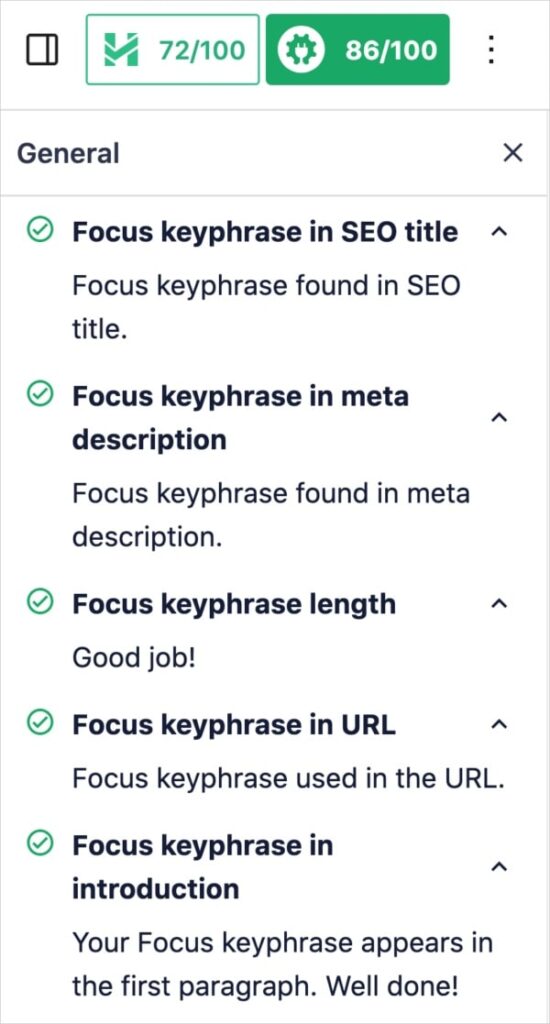
TruSEO also lets you know when your content can be improved. The keyword density metric is included at the end of this list.
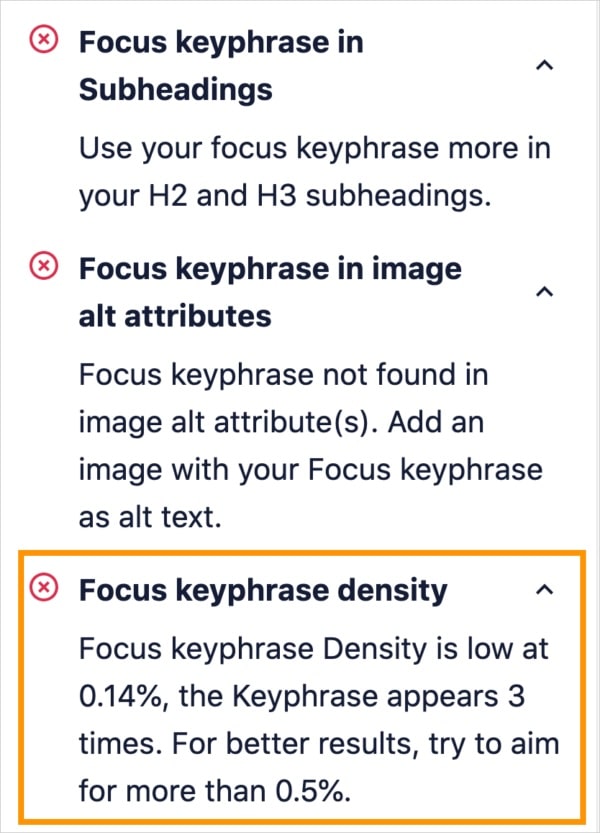
Overall, AIOSEO is a beginner-friendly plugin that provides valuable insights into keyword optimizations. By following its recommendations, you can improve your website’s rankings and attract more organic traffic.
Keyword Density FAQs
What is a good keyword density?
There’s no definitive “good” keyword density, but 1-2% is generally accepted by SEO professionals as an acceptable target. Instead of fixating on a specific percentage, focus on using your keywords naturally with your content. This approach will help you create content that is both informative and SEO-friendly.
What keyword density is too high?
There’s no hard-and-fast rule for what keyword density is too high. But in general, if you find you’re over 2%, it might be good to revisit your content. As long as you’re not keyword stuffing, you should be fine.
Does keyword density matter for SEO?
Keyword density is no longer a ranking factor. Modern search engines algorithms are sophisicated enough to understand the context of a web page and how it aligns with search intent without relying on keyword frequency. Instead, focus on creating valuable, informative content that naturally incorporates relevant keywords.
How can I calculate keyword density?
You can calculate keyword density by using the following formula: Keyword Density = (Number of Keyword Occurrences / Total Word Count) * 100.
How can I reduce keyword density?
If your keyword density is too high, incorporate variations of your target keyword. Using related keywords will help you ensure comprehensive topic coverage and improve your on-page SEO.
Final Thoughts
Keyword density used to help websites rank, but its importance has diminished significantly since then. While it’s essential to use relevant keywords, obsessing over exact percentages is counterproductive. Modern search engines prioritize high-quality content that provides genuine value to users.
Focus your efforts on creating engaging, informative content that naturally incorporates keywords. By understanding your target audience and their search intent, you can produce content that ranks well without resorting to outdated tactics like keyword stuffing.
Further reading: